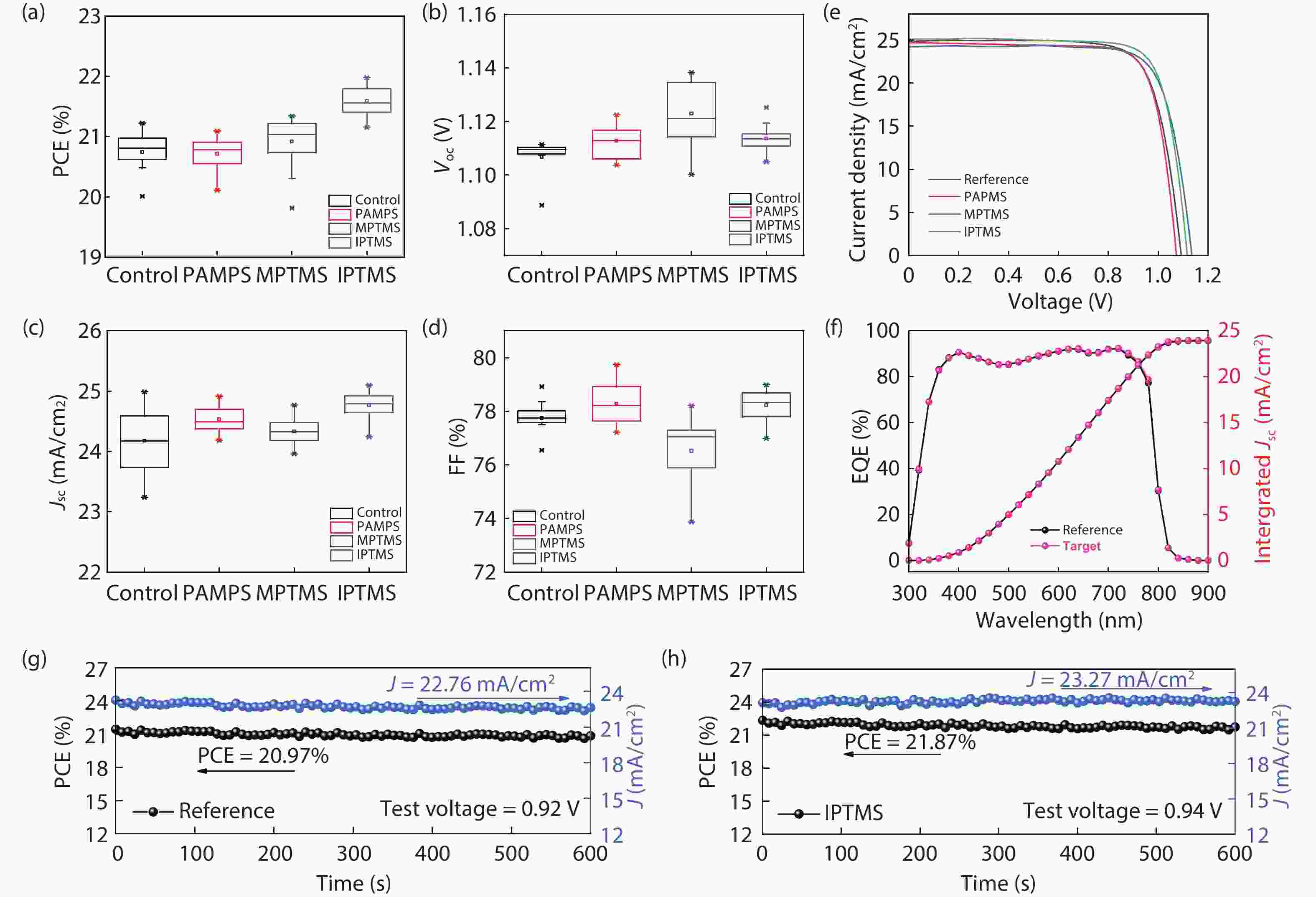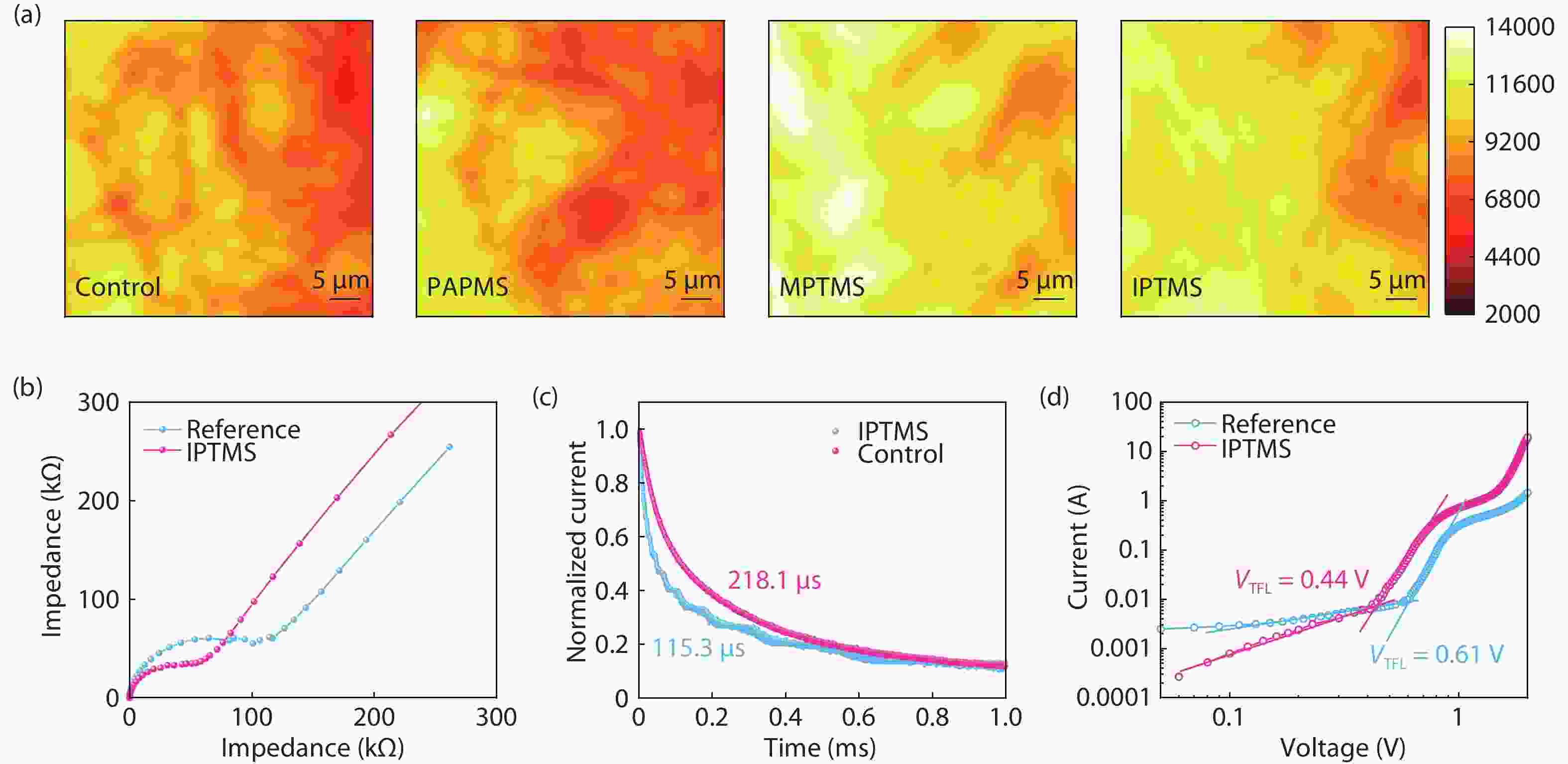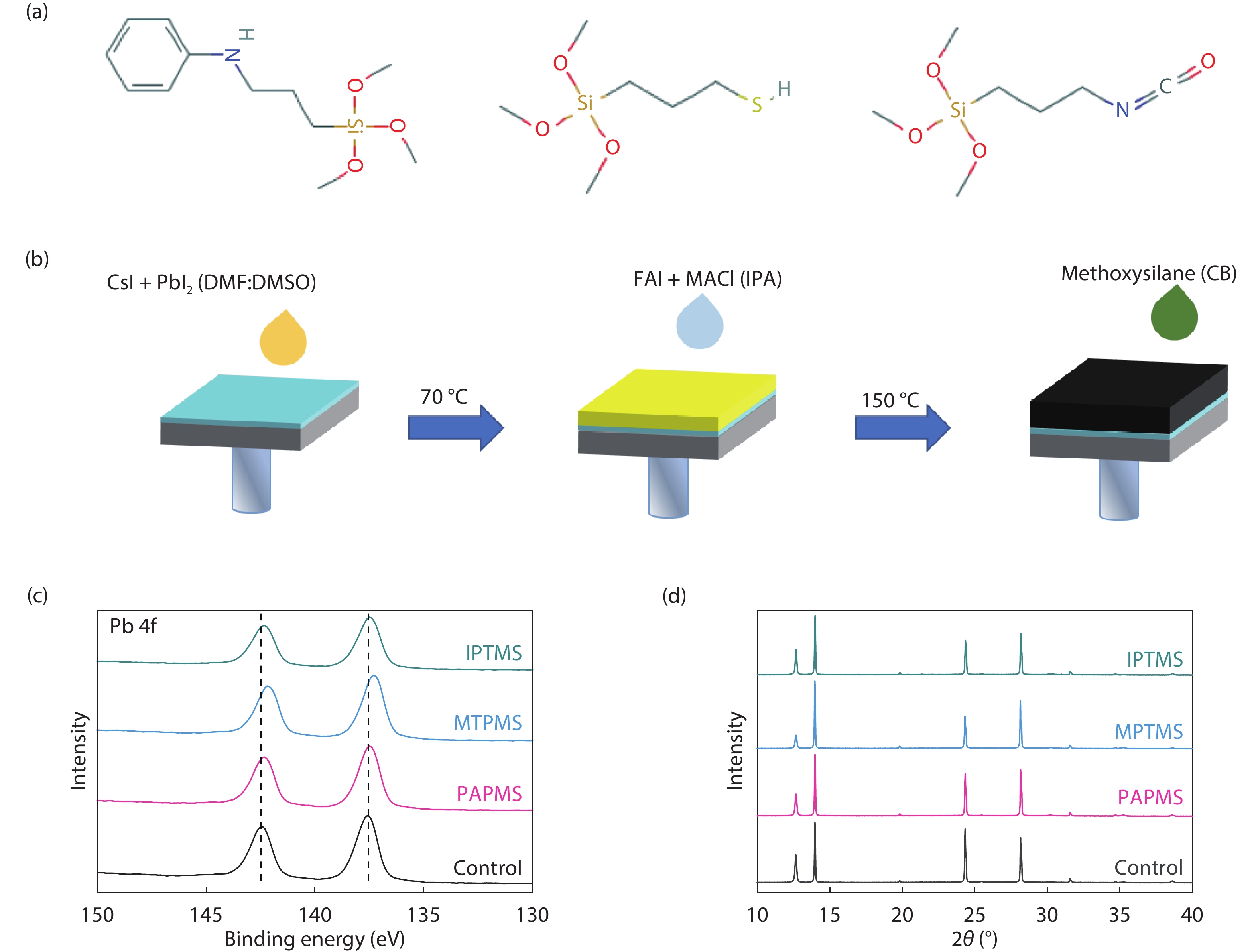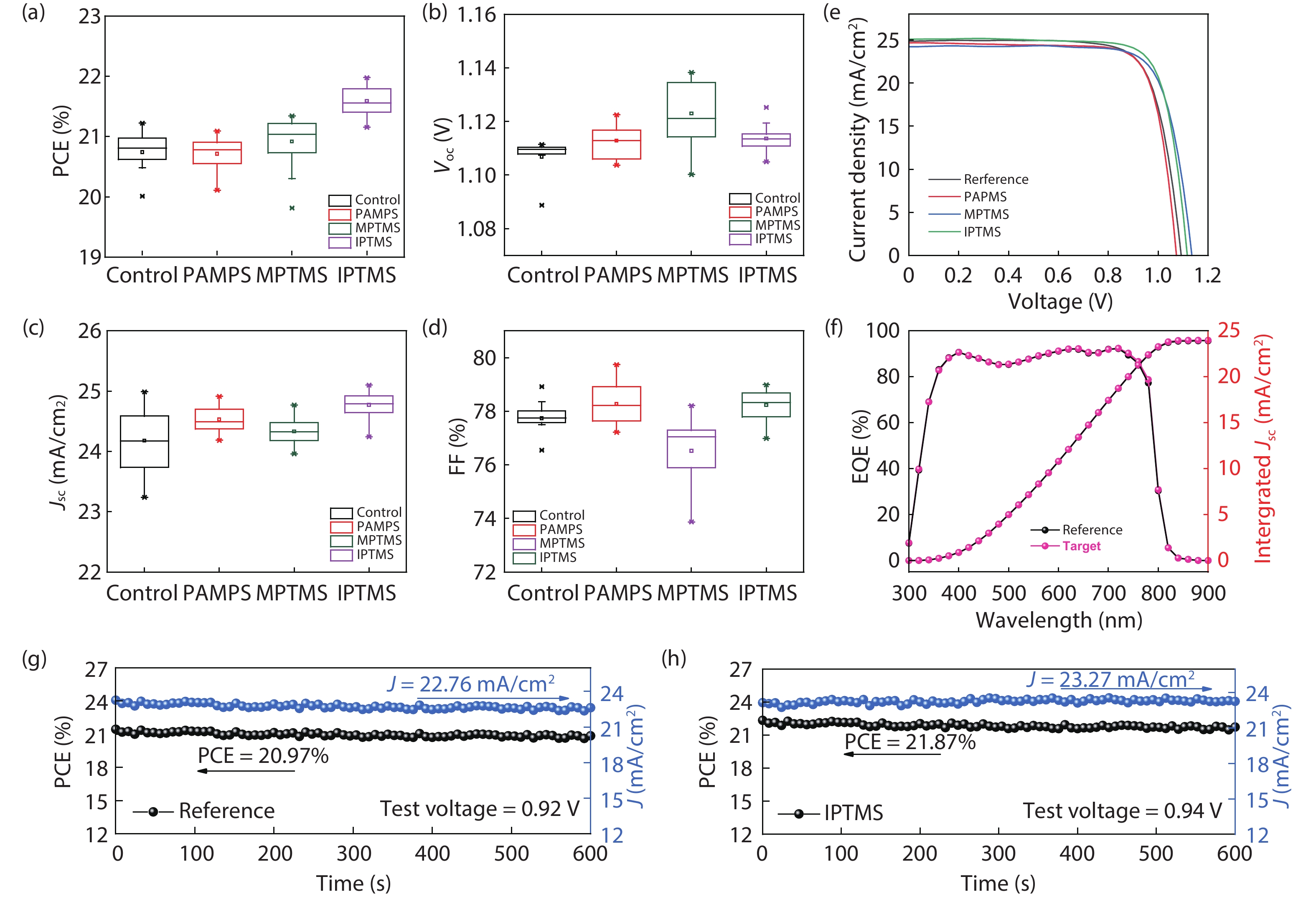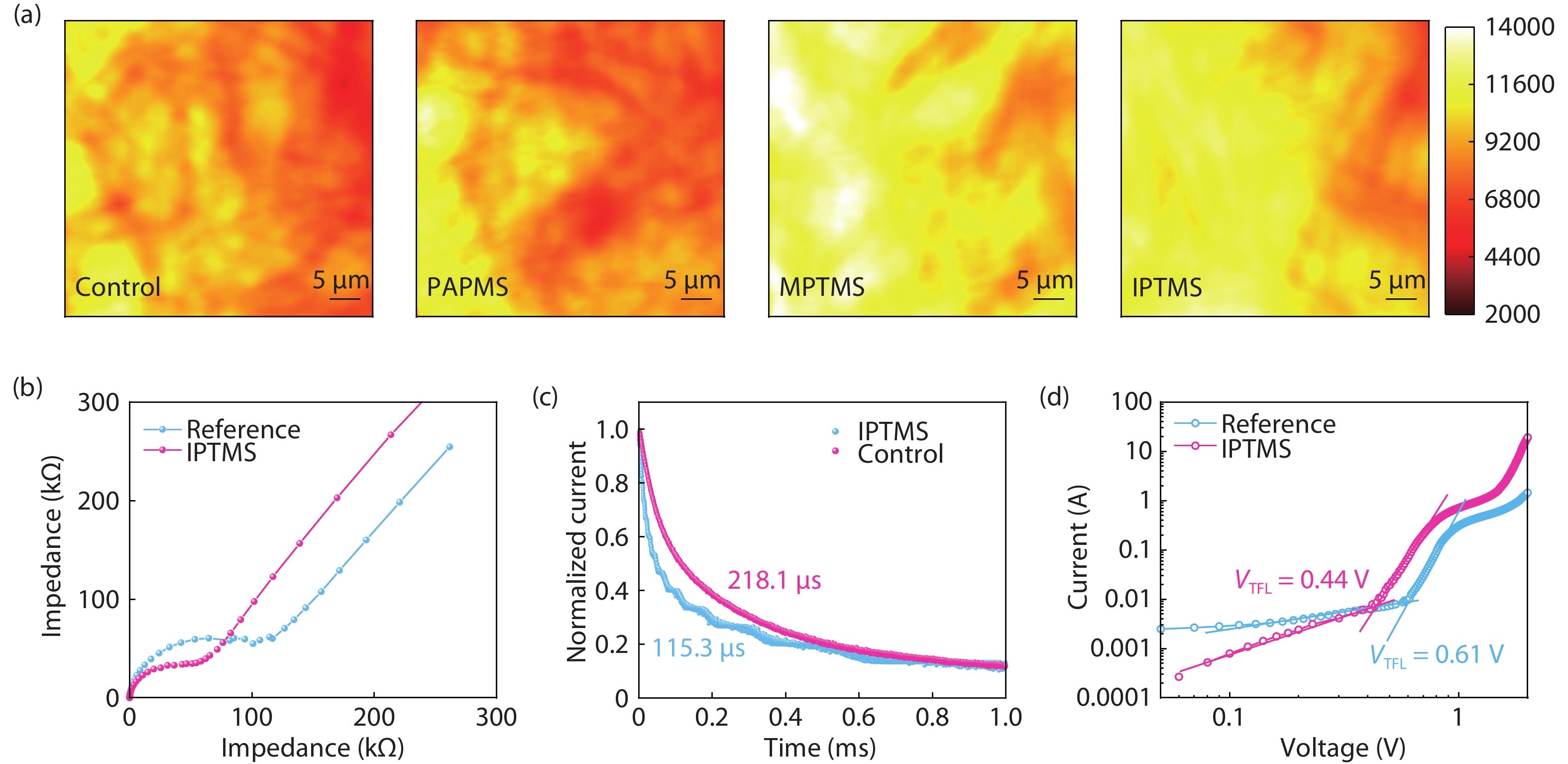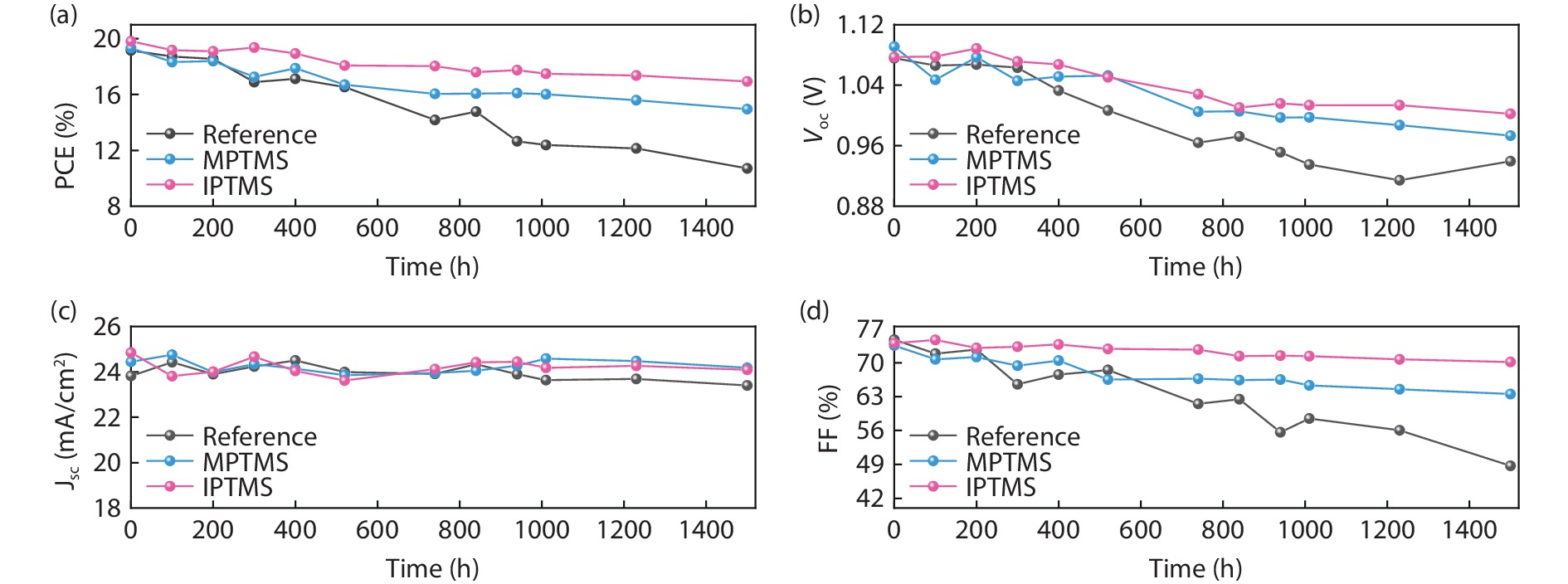| Citation: |
Xiao Zhang, Sai Ma, Jingbi You, Yang Bai, Qi Chen. Tailoring molecular termination for thermally stable perovskite solar cells[J]. Journal of Semiconductors, 2021, 42(11): 112201. doi: 10.1088/1674-4926/42/11/112201
X Zhang, S Ma, J B You, Y Bai, Q Chen, Tailoring molecular termination for thermally stable perovskite solar cells[J]. J. Semicond., 2021, 42(11): 112201. doi: 10.1088/1674-4926/42/11/112201.
Export: BibTex EndNote
|
Tailoring molecular termination for thermally stable perovskite solar cells
doi: 10.1088/1674-4926/42/11/112201
More Information-
Abstract
Interfacial engineering has made an outstanding contribution to the development of high-efficiency perovskite solar cells (PSCs). Here, we introduce an effective interface passivation strategy via methoxysilane molecules with different terminal groups. The power conversion efficiency (PCE) has increased from 20.97% to 21.97% after introducing a 3-isocyanatopropyltrimethoxy silane (IPTMS) molecule with carbonyl group, while a trimethoxy[3-(phenylamino)propyl] silane (PAPMS) molecule containing aniline group deteriorates the photovoltaic performance as a consequence of decreased open circuit voltage. The improved performance after IPTMS treatment is ascribed to the suppression of non-radiative recombination and enhancement of carrier transportation. In addition, the devices with carbonyl group modification exhibit outstanding thermal stability, which maintain 90% of its initial PCE after 1500 h exposure. This work provides a guideline for the design of passivation molecules aiming to deliver the efficiency and thermal stability simultaneously. -
References
[1] Im J H, Jang I H, Pellet N, et al. Growth of CH3NH3PbI3 cuboids with controlled size for high-efficiency perovskite solar cells. Nat Nanotechnol, 2014, 9, 927 doi: 10.1038/nnano.2014.181[2] Sun S Y, Salim T, Mathews N, et al. The origin of high efficiency in low-temperature solution-processable bilayer organometal halide hybrid solar cells. Energy Environ Sci, 2014, 7, 399 doi: 10.1039/C3EE43161D[3] Dong Q F, Fang Y J, Shao Y C, et al. Electron-hole diffusion lengths > 175 μm in solution-grown CH3NH3PbI3 single crystals. Science, 2015, 347, 967 doi: 10.1126/science.aaa5760[4] Shi D, Adinolfi V, Comin R, et al. Low trap-state density and long carrier diffusion in organolead trihalide perovskite single crystals. Science, 2015, 347, 519 doi: 10.1126/science.aaa2725[5] Stranks S D, Eperon G E, Grancini G, et al. Electron-hole diffusion lengths exceeding 1 micrometer in an organometal trihalide perovskite absorber. Science, 2013, 342, 341 doi: 10.1126/science.1243982[6] Chang N L, Yi Ho-Baillie A W, Basore P A, et al. A manufacturing cost estimation method with uncertainty analysis and its application to perovskite on glass photovoltaic modules. Prog Photovolt: Res Appl, 2017, 25, 390 doi: 10.1002/pip.2871[7] National Renewable Energy Laboratory. Best research-cell efficiencies chart (2020). https://www.nrel.gov/pv/cell-efficiency.html[8] Kojima A, Teshima K, Shirai Y, et al. Organometal halide perovskites as visible-light sensitizers for photovoltaic cells. J Am Chem Soc, 2009, 131, 6050 doi: 10.1021/ja809598r[9] Kim H S, Lee C R, Im J H, et al. Lead iodide perovskite sensitized all-solid-state submicron thin film mesoscopic solar cell with efficiency exceeding 9%. Sci Rep, 2012, 2, 591 doi: 10.1038/srep00591[10] Zhou H P, Chen Q, Li G, et al. Interface engineering of highly efficient perovskite solar cells. Science, 2014, 345, 542 doi: 10.1126/science.1254050[11] Jiang Q, Zhao Y, Zhang X W, et al. Surface passivation of perovskite film for efficient solar cells. Nat Photonics, 2019, 13, 460 doi: 10.1038/s41566-019-0398-2[12] Jeong M, Choi I W, Go E M, et al. Stable perovskite solar cells with efficiency exceeding 24.8% and 0.3-V voltage loss. Science, 2020, 369, 1615 doi: 10.1126/science.abb7167[13] Yin W J, Shi T T, Yan Y F. Unusual defect physics in CH3NH3PbI3 perovskite solar cell absorber. Appl Phys Lett, 2014, 104, 063903 doi: 10.1063/1.4864778[14] Sherkar T S, Momblona C, Gil-Escrig L, et al. Recombination in perovskite solar cells: Significance of grain boundaries, interface traps, and defect ions. ACS Energy Lett, 2017, 2, 1214 doi: 10.1021/acsenergylett.7b00236[15] Yavari M, Mazloum-Ardakani M, Gholipour S, et al. Reducing surface recombination by a poly(4-vinylpyridine) interlayer in perovskite solar cells with high open-circuit voltage and efficiency. ACS Omega, 2018, 3, 5038 doi: 10.1021/acsomega.8b00555[16] Correa-Baena J P, Tress W, Domanski K, et al. Identifying and suppressing interfacial recombination to achieve high open-circuit voltage in perovskite solar cells. Energy Environ Sci, 2017, 10, 1207 doi: 10.1039/C7EE00421D[17] Son D Y, Lee J W, Choi Y J, et al. Self-formed grain boundary healing layer for highly efficient CH3NH3PbI3 perovskite solar cells. Nat Energy, 2016, 1, 16081 doi: 10.1038/nenergy.2016.81[18] Tumen-Ulzii G, Qin C J, Klotz D, et al. Detrimental effect of unreacted PbI2 on the long-term stability of perovskite solar cells. Adv Mater, 2020, 32, 1905035 doi: 10.1002/adma.201905035[19] Liu T H, Zhou Y Y, Li Z, et al. Stable formamidinium-based perovskite solar cells via in situ grain encapsulation. Adv Energy Mater, 2018, 8, 1800232 doi: 10.1002/aenm.201800232[20] Sutton R J, Eperon G E, Miranda L, et al. Bandgap-tunable cesium lead halide perovskites with high thermal stability for efficient solar cells. Adv Energy Mater, 2016, 6, 1502458 doi: 10.1002/aenm.201502458[21] Lee J W, Kim D H, Kim H S, et al. Formamidinium and cesium hybridization for photo- and moisture-stable perovskite solar cell. Adv Energy Mater, 2015, 5, 1501310 doi: 10.1002/aenm.201501310[22] Zhang Y, Seo S, Lim S Y, et al. Achieving reproducible and high-efficiency (> 21%) perovskite solar cells with a presynthesized FAPbI3 powder. ACS Energy Lett, 2020, 5, 360 doi: 10.1021/acsenergylett.9b02348[23] Wang H, Zhu C, Liu L, et al. Interfacial residual stress relaxation in perovskite solar cells with improved stability. Adv Mater, 2019, 31, 1904408 doi: 10.1002/adma.201904408[24] Yang S, Chen S S, Mosconi E, et al. Stabilizing halide perovskite surfaces for solar cell operation with wide-bandgap lead oxysalts. Science, 2019, 365, 473 doi: 10.1126/science.aax3294[25] Zhang Z H, Li J, Fang Z M, et al. Adjusting energy level alignment between HTL and CsPbI2Br to improve solar cell efficiency. J Semicond, 2021, 42, 030501 doi: 10.1088/1674-4926/42/3/030501[26] Fang Z M, Meng X Y, Zuo C T, et al. Interface engineering gifts CsPbI2.25Br0.75 solar cells high performance. Sci Bull, 2019, 64, 1743 doi: 10.1016/j.scib.2019.09.023[27] Wan F, Ke L L, Yuan Y B, et al. Passivation with crosslinkable diamine yields 0.1 V non-radiative Voc loss in inverted perovskite solar cells. Sci Bull, 2021, 66, 417 doi: 10.1016/j.scib.2020.10.010[28] Cheng M, Zuo C T, Wu Y Z, et al. Charge-transport layer engineering in perovskite solar cells. Sci Bull, 2020, 65, 1237 doi: 10.1016/j.scib.2020.04.021[29] Zhu L F, Xu Y Z, Zhang P P, et al. Investigation on the role of Lewis bases in the ripening process of perovskite films for highly efficient perovskite solar cells. J Mater Chem A, 2017, 5, 20874 doi: 10.1039/C7TA05378A[30] Shao Y C, Xiao Z G, Bi C, et al. Origin and elimination of photocurrent hysteresis by fullerene passivation in CH3NH3PbI3 planar heterojunction solar cells. Nat Commun, 2014, 5, 5784 doi: 10.1038/ncomms6784[31] Xu J X, Buin A, Ip A H, et al. Perovskite–fullerene hybrid materials suppress hysteresis in planar diodes. Nat Commun, 2015, 6, 7081 doi: 10.1038/ncomms8081[32] Zheng X P, Chen B, Dai J, et al. Defect passivation in hybrid perovskite solar cells using quaternary ammonium halide anions and cations. Nat Energy, 2017, 2, 1 doi: 10.1038/nenergy.2017.102[33] Tan H R, Jain A, Voznyy O, et al. Efficient and stable solution-processed planar perovskite solar cells via contact passivation. Science, 2017, 355, 722 doi: 10.1126/science.aai9081[34] Rajagopal A, Stoddard R J, Jo S B, et al. Overcoming the photovoltage plateau in large bandgap perovskite photovoltaics. Nano Lett, 2018, 18, 3985 doi: 10.1021/acs.nanolett.8b01480[35] Yang D, Zhou X, Yang R X, et al. Surface optimization to eliminate hysteresis for record efficiency planar perovskite solar cells. Energy Environ Sci, 2016, 9, 3071 doi: 10.1039/C6EE02139E -
Supplements
 2021-112201-suppl.pdf
2021-112201-suppl.pdf

-
Proportional views





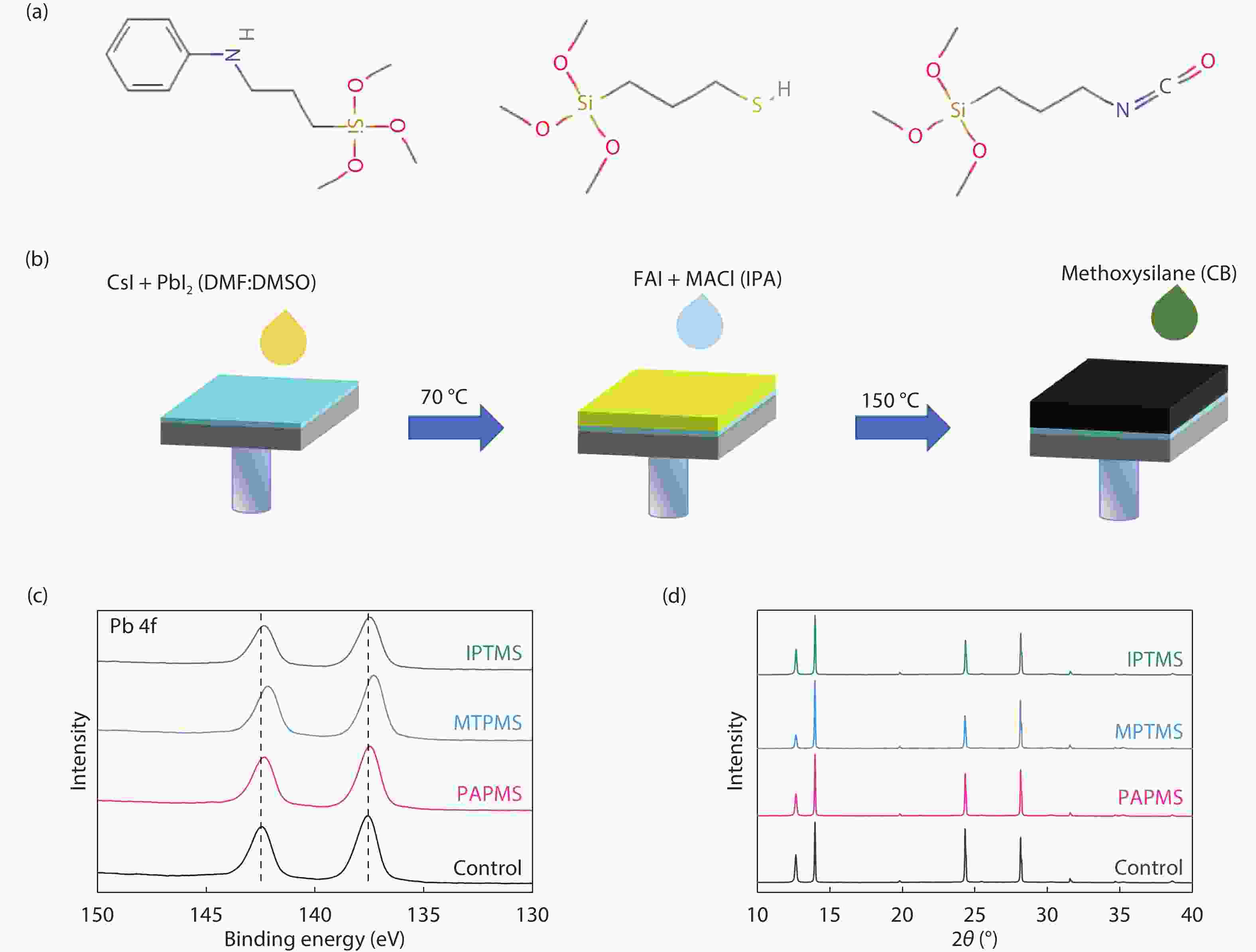
 DownLoad:
DownLoad:
